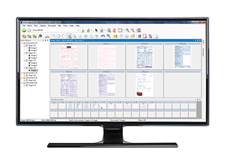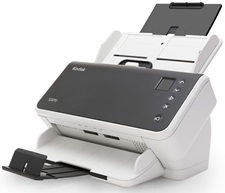How to Create a Paperless Hospital
Medical facilities are one of the industries that use the most paper, coming in second to legal firms. Although going completely paperless right away may not be possible, reducing the use of paper at medical clinics and hospitals is a step in the right direction.
The digitalization of aspects such as client check-in and medical records should not only make workflow processes more efficient but also decrease manual errors and keep personal patient information more secure than ever.
Taking the First Step
If switching from consistent paper use to complete digitalization was easy and instant, every industry would go paperless. Digitalization requires having a detailed plan and begins with recognizing where digital processes could improve workflow.
The administration side of medical facilities, particularly patient check-in processes, would be a beneficial spot to begin digitalization. Similarly, storing patients’ medical records electronically would not only free up physical storage space but provide more security for sensitive information.
Patient and doctor communication is also an opportune area for going paperless. Clinical communication software can assist with digitalizing doctor-patient correspondence, prescription ordering, appointment setting, and the patient’s access to their own medical information.
You can’t begin the hospital-wide process digitalization all at once. After deciding what to digitize, ensure you have the proper digital software and tools, then establish a process for document workflows and finally, begin training hospital staff on how to use different paperless processes such as new software and the handling of electronic medical records. Establishing a step by step process for total digitalization in waves will make things run smoothly as everyone gets adjusted.
[Related: A Major U.S. Health System and School of Medicine Rolls Out Distributed Capture to 400+ Locations]
Getting the Right Tools
IT Staff
Creating a paperless hospital means introducing new technological tools such as digital software, computer programs, document scanners, and more that may run into technical issues. Having a 24/7 IT support team on staff that knows how to set everything up as well as address and fix issues quickly and confidently will keep your hospital running smoothly — and help keep you on the right track to providing excellent patient care.
Electronic Medical Records (EMR) Software
Electronic medical records (EMR) software will be crucial to your paperless workflows. EMR is a systematized collection of patient data and records stored in a digital format. Having patient medical records stored digitally frees up physical space by eliminating physical file storage areas, makes it easier to share information across medical departments and doctors, and also stores data more securely with less possibility for manual error.
Clinical Communication Software
Gone are the days of messy handwritten prescriptions and waiting for days to hear back from your doctor. With clinical communication software, patients can instant message their doctor or an online health representative, send emails, request appointments and prescription refills, and access their own medical records at the drop of a dime.
Investing in clinical communication for your hospital is an excellent way to eliminate paper use, streamline workflow processes and communication, and make your patient feel involved, secure, and happy.
Document Scanners and Software
Digitalizing existing records and being prepared to convert future paperwork that comes in starts with choosing the right software and document scanner for a medical facility.
Medical document scanners need to be able to scan patient records and different types and sizes of documents easily, such as identification cards and insurance papers. Your scanners will ideally have optical character recognition (OCR), making it simple to search through scanned documents for certain keywords or information, and eliminating the need to go back and sort through everything you’ve just scanned.
Crucially, your scanners must also adhere to any compliance legislation governing the handling of personal data. See our picks for the best document scanners for health care, both in terms of compliance and the other necessary features.
Sharing information across departments, whether to a cloud-based server or email, is another aspect of medical document scanners that is essential to streamlining workflow and decreasing the need for paper documents. Capture software helps you integrate paper and images originating from existing patient records, new patients and other vital documents into servers and EMR workflows. The right software will capture the information from scanners, mobile devices, faxes, emails, or MFPs and extract the data required to automatically associate them with the right EMRs. It can identify the information in a patient record, such as a medical record number, date of birth, patient name, etc.
What to Know: TWAIN Standard
TWAIN is a graphic and imaging standard initially created in 1991 by the TWAIN Working Group in order to standardize communication and compatibility between home computers and document scanning software. The TWAIN Working Group aims to provide multi-platform support, encourage ease of use, and foster a universal public standard for the way image acquisition devices, such as document scanners, work with applications and home computers.
When going paperless and using document scanning software, look for products that offer TWAIN compatibility. A TWAIN driver is usually included as part of the software package to ease the compatibility between the scanned document and its digital copy. The driver allows users to scan the document directly into whichever application they need to work with.
[Related: The Complete Guide to Going Paperless]
Lo que hay que saber: Reglamento General de Protección de Datos
La Unión Europea promulgó la Directiva de Protección de Datos (DPD), conocida oficialmente como la Directiva 95/46/CE, en 1995 para regular la circulación y el tratamiento de datos personales, incluida la información médica y sanitaria. Esto asegura que dicha información permanezca protegida y confidencial entre las entidades cubiertas (por ejemplo, el paciente y el proveedor de servicios sanitarios) y que solo se comparta con el consentimiento explícito del propietario de la información.
La Directiva de Protección de Datos se desarrolló a partir de los siete principios de las Recomendaciones de 1980 del Consejo de la Organización de Cooperación y Desarrollo Económicos (OCDE) en relación con las directrices que regulan la protección de la privacidad y los flujos transfronterizos de datos personales. Los siete principios son:
- Notificación
- Propósito
- Consentimiento
- Seguridad
- Divulgación
- Acceso
- Rendición de cuentas
El DPD fue eliminado progresivamente y sustituido en 2018 por el Reglamento General de Protección de Datos (GDPR). Este reglamento mejora la DPD al regular leyes en todos los Estados miembros, mientras que mantiene los mismos principios básicos sobre el intercambio de información y datos personales.
Después de escanear y digitalizar la información médica con un escáner de documentos, esa información se convierte en información médica protegida digital y sigue estando protegida por el GDPR.
Mantenga las regulaciones del GDPR como una prioridad con su plan para abandonar del uso de papel y elegir herramientas y procesos que le ayuden a proteger dicha información.
Perspectivas y estudios de casos
Cómo elegir el escáner de documentos adecuado para el sector de Salud
De Kara Rayburn, gerenta global, Marketing de Productos y Web¿Cuáles son las funciones adecuadas que se deben tener en cuenta a la hora de elegir los mejores escáneres para la atención de la salud y la digitalización de historiales médicos?
Guía para dejar el papel
El valor de la transición de su empresa a un mundo digital y cómo hacerlo
Soluciones relacionadas

Software Capture Pro
- Ideal para aplicaciones empresariales en las que se usa gran cantidad de papel
- Amplia integración con sistemas ECM
- Módulos de importación y redes disponibles

Escáner S2070
70 ppm | AAD de 80 hojas- Rápido y potente
- Sistema de alimentación activa (AFS) integrado
- Procesamiento de imágenes incrustadas
- Iluminación de luz dual (DLI)
ACERCA DE ALARIS, UNA DIVISIÓN COMERCIAL DE KODAK ALARIS
Kodak Alaris es un proveedor líder de captura de información y soluciones de procesamiento inteligente de documentos que simplifican los procesos comerciales. Existimos para ayudar al mundo a dar sentido a la información con soluciones inteligentes y conectadas impulsadas por décadas de innovación en la ciencia de la imagen. Nuestro software, escáneres y servicios profesionales galardonados están disponibles en todo el mundo y a través de nuestra red de socios de canal.
Aviso de privacidad | Términos legales/del sitio | Aviso de recogida de California | No comparta mi información personal
© 2024 Kodak Alaris Inc. TM/MC/MR: Alaris, ScanMate. Todas las marcas y nombres comerciales utilizados son propiedad de sus respectivos titulares. La marca registrada y la imagen comercial de Kodak se usan bajo licencia de Eastman Kodak Company.

